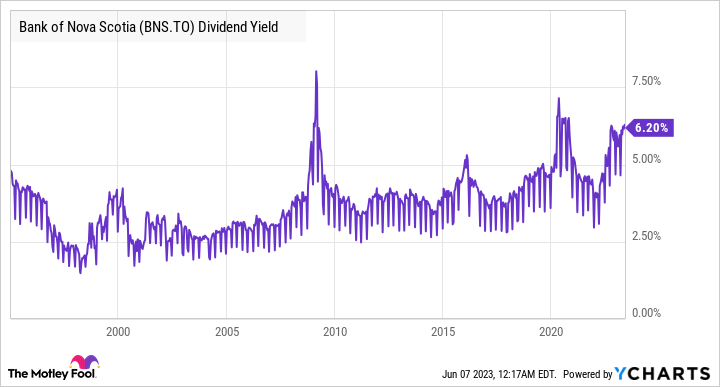The Yield on This Canadian Bank Stock Will Make You Smile

Written by Kay Ng at The Motley Fool Canada
Canadians can get yields of up to 5.1% on a one-year Guaranteed Investment Certificate (GIC), which is decent income. You are guaranteed to get your principal back, so in that sense, the income is a risk-free return. However, it is interest income, which is taxed at your marginal tax rate, just like the income you get from your job.
The GIC interest rate has gone up in the last year or so because the Bank of Canada has increased the policy interest rate with the intention to curb inflation, which has gone down to about 4.4% since peaking at 8.1% in June 2022.
If you like the 5.1% GIC, this Canadian bank stock’s yield will make you smile wider. For taking on greater risk and withstanding stock price volatility, investors can buy some Bank of Nova Scotia (TSX:BNS) shares for a juicier yield. This dividend income is taxed at a lower rate than interest income in non-registered accounts. Along with most of its big Canadian bank peers, the bank stock bumped up its quarterly dividend last month. Specifically, it boosted its dividend by about 2.9% so that it now offers a whopping yield of approximately 6.4%.
Observing BNS’s history of dividend yields, we see that it’s at the high end of the range, which can indicate it’s a good buy to lock in a relatively high yield.
BNS Dividend Yield data by YCharts
How safe is Bank of Nova Scotia stock’s dividend?
For one, Bank of Nova Scotia has never missed a dividend payment since it declared its first dividend in 1833. That’s about 190 years of continuous dividend payments!
Furthermore, the bank continues to pay out less than its earnings for its dividends, despite higher provisions for credit losses (PCL) in a riskier macro environment. Specifically, its trailing 12-month payout ratio was almost 60% of its net income available to common shareholders.
Additionally, Bank of Nova Scotia has a large reserve of close to $55 billion in its retained earnings that can serve as a buffer for about 10 years of dividend payments if needed. Importantly, there’s no reason to believe that it will need to draw from this reserve to pay dividends, because its payout ratio remains sustainable. That said, it is also true that its payout ratio is normally at or below 50%.
The higher payout ratio suggests heightened risk in investing in the bank stock in the near term and, therefore, the stock has corrected, and its dividend yield pushed higher. This payout ratio is similar to the level it experienced in fiscal 2008/09 around the Global Financial Crisis.
Investor takeaway
The bank just reported its fiscal second-quarter results late last month. It remains well capitalized, as it ended the quarter with a common equity tier-one capital ratio of 12.3%. In addition, fiscal year to date, its PCL on impaired loans was 0.31% of average net loans and acceptances, which is about 40% lower than the percentage in fiscal 2021.
Still, the current market does not like Bank of Nova Scotia’s exposure to greater-risk international markets, which has weighed on the stock price. At $66.50 per share, the bank stock has declined about 21% in the last 12 months. An improvement in the macro environment can allow long-term investors to experience sizeable capital gains. In the meantime, they can enjoy outsized dividend income.
The post The Yield on This Canadian Bank Stock Will Make You Smile appeared first on The Motley Fool Canada.
Should You Invest $1,000 In Bank of Nova Scotia?
Before you consider Bank of Nova Scotia, you'll want to hear this.
Our market-beating analyst team just revealed what they believe are the 5 best stocks for investors to buy in May 2023... and Bank of Nova Scotia wasn't on the list.
The online investing service they've run for nearly a decade, Motley Fool Stock Advisor Canada, is beating the TSX by 23 percentage points. And right now, they think there are 5 stocks that are better buys.
See the 5 Stocks * Returns as of 5/24/23
More reading
Fool contributor Kay Ng has positions in Bank Of Nova Scotia. The Motley Fool recommends Bank Of Nova Scotia. The Motley Fool has a disclosure policy.
2023

 Yahoo Finance
Yahoo Finance 
